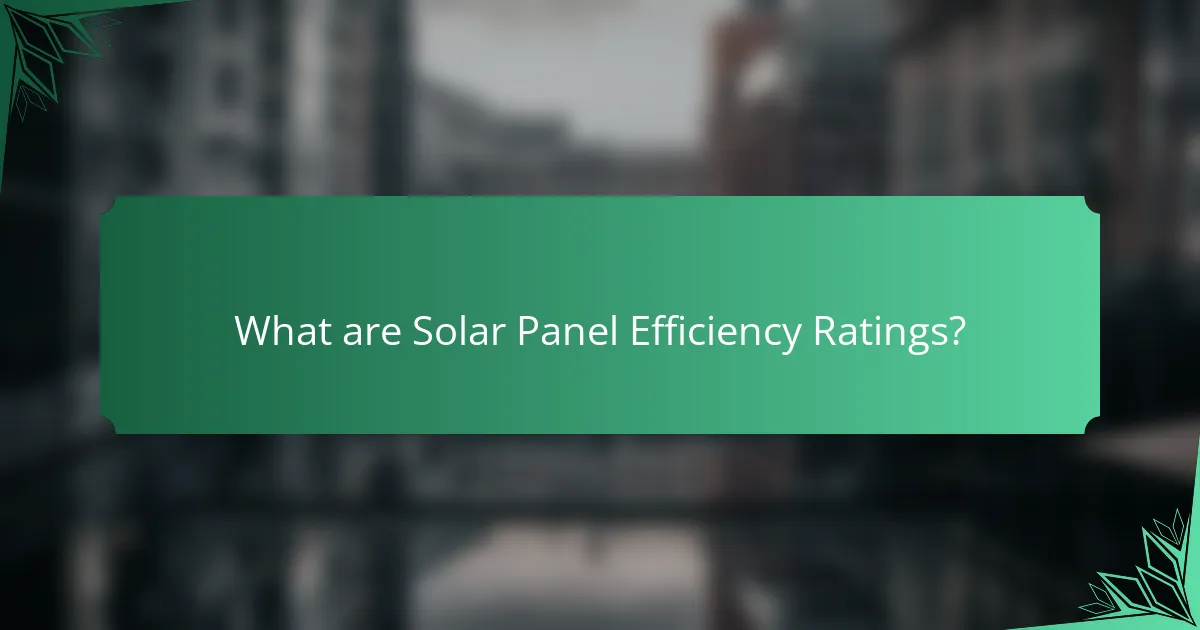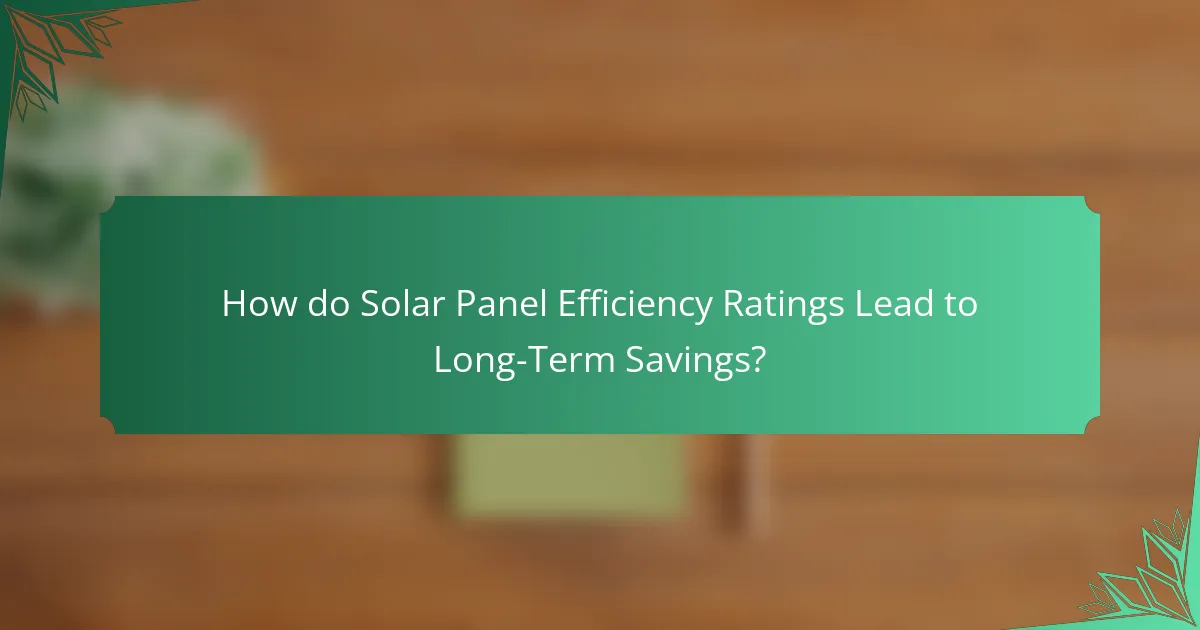
What are Solar Panel Efficiency Ratings?
Solar panel efficiency ratings measure how effectively a solar panel converts sunlight into usable electricity. These ratings are expressed as a percentage. Higher percentages indicate better performance. Most solar panels range from 15% to 22% efficiency. For example, a panel with 20% efficiency converts 20% of sunlight into electricity. Efficiency impacts energy output and long-term savings. Higher efficiency panels can generate more electricity in less space. This is crucial for maximizing energy production, especially in limited areas.
How are solar panel efficiency ratings determined?
Solar panel efficiency ratings are determined by measuring the amount of sunlight converted into usable electricity. This process involves standardized testing under controlled conditions. The most common standard is the International Electrotechnical Commission (IEC) 61215. During testing, panels are exposed to a light intensity of 1000 watts per square meter. The output power is measured in watts. The efficiency is calculated by dividing the electrical output by the solar input. For example, a panel producing 300 watts under these conditions will have an efficiency rating of 18%. This rating helps consumers compare the energy production potential of different panels. Higher efficiency ratings generally indicate better performance and can lead to long-term savings.
What factors influence the efficiency of solar panels?
The efficiency of solar panels is influenced by several key factors. These include the type of solar cells used, which can vary in efficiency rates. Monocrystalline solar panels generally have higher efficiency than polycrystalline panels. The angle and orientation of the panels also play a critical role. Panels positioned at the optimal angle to the sun can capture more sunlight.
Temperature affects performance as well; higher temperatures can reduce the efficiency of solar cells. Additionally, shading from trees, buildings, or debris can significantly decrease energy output. The quality of installation impacts efficiency; poorly installed panels may not perform optimally. Lastly, the presence of dust and dirt on the panels can obstruct sunlight, leading to reduced efficiency.
Research shows that optimal panel placement can increase energy output by up to 25%. According to the National Renewable Energy Laboratory, maintaining clean panels can improve performance by 10% to 30%.
Why is efficiency an important metric for solar panels?
Efficiency is an important metric for solar panels because it directly affects the amount of electricity generated from sunlight. Higher efficiency means more energy production per square meter of solar panel. This is crucial for maximizing space, especially in urban areas where installation space is limited.
For example, a solar panel with 20% efficiency converts 20% of sunlight into electricity, while a 25% efficient panel generates 25% of the same sunlight. This difference can lead to significant energy savings over time.
Moreover, efficient solar panels can lower overall system costs. Fewer panels may be needed to achieve the same energy output, reducing installation and maintenance expenses.
Research indicates that higher efficiency panels can lead to greater long-term savings. According to the National Renewable Energy Laboratory, increasing panel efficiency by just a few percentage points can result in thousands of dollars saved over the lifespan of the system.
In summary, solar panel efficiency is vital for optimizing energy output, reducing costs, and enhancing overall system performance.
What do solar panel efficiency ratings mean for consumers?
Solar panel efficiency ratings indicate how effectively a solar panel converts sunlight into electricity. Higher efficiency ratings mean more electricity generation from the same amount of sunlight. For consumers, this translates to reduced energy bills and quicker return on investment. For example, a panel with 20% efficiency produces more power than one with 15% efficiency under identical conditions. This efficiency can also influence the amount of space needed for installation. Consumers with limited roof space benefit from higher efficiency panels. Additionally, efficient panels can lead to a smaller carbon footprint and contribute to environmental sustainability. Thus, understanding these ratings is crucial for making informed purchasing decisions.
How can efficiency ratings affect energy production?
Efficiency ratings directly influence energy production by indicating how effectively solar panels convert sunlight into electricity. Higher efficiency ratings mean more electricity generated per square foot of solar panel. This leads to increased energy output, especially in limited installation spaces. For example, panels with a 20% efficiency rating produce more energy than those rated at 15%. According to the U.S. Department of Energy, higher efficiency panels can lead to lower energy costs over time. Therefore, selecting panels with better efficiency ratings can significantly enhance overall energy production and long-term savings.
What should consumers look for in efficiency ratings?
Consumers should look for the percentage value of efficiency ratings in solar panels. This percentage indicates how much sunlight the panel can convert into usable electricity. Higher efficiency ratings mean more energy production from the same amount of sunlight. Consumers should also consider the performance warranty associated with the efficiency rating. A longer warranty often signifies greater confidence in the panel’s performance over time. Additionally, consumers should evaluate the temperature coefficient. A lower temperature coefficient indicates better performance in high temperatures. Finally, consumers should check third-party certifications for reliability. Certifications from organizations like the International Electrotechnical Commission (IEC) ensure that efficiency claims are verified.

How do Solar Panel Efficiency Ratings Lead to Long-Term Savings?
Solar panel efficiency ratings directly influence long-term savings by determining how much electricity a panel can generate. Higher efficiency ratings mean more energy production from the same amount of sunlight. This increased output reduces reliance on grid electricity, leading to lower utility bills. For instance, a solar panel with a 20% efficiency rating can produce significantly more energy than one with a 15% rating over its lifetime.
According to the U.S. Department of Energy, a higher efficiency can lead to savings of thousands of dollars over 25 years. Additionally, efficient panels often come with longer warranties, ensuring durability and performance. These factors combined mean that investing in higher-rated solar panels can yield greater financial benefits in the long run.
What is the relationship between efficiency and cost savings?
Efficiency directly impacts cost savings. Higher efficiency in solar panels means more energy production from the same amount of sunlight. This increased energy output leads to reduced electricity bills. For example, a solar panel with 20% efficiency generates more power than one with 15% efficiency. Consequently, homeowners save more on energy costs with higher efficiency panels. Studies show that investing in high-efficiency solar panels can yield greater long-term savings. Thus, the relationship between efficiency and cost savings is significant and beneficial for consumers.
How do higher efficiency ratings translate to lower energy bills?
Higher efficiency ratings in solar panels lead to lower energy bills by producing more electricity from the same amount of sunlight. Higher efficiency means that a greater percentage of solar energy is converted into usable power. This results in reduced reliance on grid electricity, which decreases monthly energy costs. For example, a panel with a 20% efficiency rating generates more energy than one with a 15% rating under identical conditions. Consequently, homeowners can offset their energy consumption more effectively. According to the U.S. Department of Energy, higher efficiency panels can save homeowners hundreds of dollars over the lifespan of the system. This translates to lower energy bills as less electricity needs to be purchased from utility providers.
What are the long-term financial benefits of investing in efficient solar panels?
Investing in efficient solar panels provides significant long-term financial benefits. They reduce electricity bills by generating renewable energy, which can lead to savings of thousands of dollars over their lifespan. Efficient solar panels typically have a longer lifespan, often exceeding 25 years, maximizing the return on investment.
Additionally, they can increase property value. Homes equipped with solar energy systems often sell for more than those without. According to a study by the National Renewable Energy Laboratory, homes with solar panels sold for an average of $15,000 more than comparable homes without solar systems.
Tax incentives and rebates further enhance the financial benefits of solar investments. Many regions offer tax credits that can cover a substantial portion of installation costs. Moreover, efficient solar panels often qualify for performance-based incentives, providing ongoing financial rewards based on energy production.
In summary, the long-term financial benefits of investing in efficient solar panels include reduced energy costs, increased property value, and financial incentives that enhance overall savings.
How can consumers maximize savings through solar panel efficiency?
Consumers can maximize savings through solar panel efficiency by selecting high-efficiency panels. High-efficiency solar panels convert more sunlight into electricity, resulting in greater energy production. This increased output reduces reliance on grid electricity, lowering utility bills.
Choosing panels with efficiency ratings above 20% can significantly enhance savings. According to the National Renewable Energy Laboratory, higher efficiency panels can produce 30% more energy over their lifetime compared to standard panels.
Additionally, consumers should consider installing panels in optimal locations to maximize sunlight exposure. Regular maintenance, such as cleaning and inspections, ensures panels operate at peak efficiency. Investing in energy storage systems can also enhance savings by allowing consumers to use stored energy during peak pricing hours.
What strategies can enhance the performance of solar panels?
Regular cleaning of solar panels enhances their performance by removing dirt and debris. Dirty panels can lose up to 25% of their efficiency. Installing solar panels at the correct angle maximizes sun exposure. This positioning can significantly increase energy production. Using high-quality solar inverters improves energy conversion rates. Inverters with higher efficiency ratings can optimize overall system performance. Monitoring system performance regularly helps identify issues early. Early detection can prevent significant energy losses. Upgrading to more efficient panel technology can provide better energy output. Newer models often have higher efficiency ratings than older ones. Implementing energy storage solutions can enhance the utility of generated power. Storage systems allow for energy use during non-sunny periods, maximizing efficiency.
How does maintenance impact solar panel efficiency and savings?
Regular maintenance significantly enhances solar panel efficiency and savings. Clean solar panels absorb more sunlight, leading to increased energy production. Dust, debris, and bird droppings can reduce efficiency by up to 25%. Routine inspections identify issues like wiring problems or shading that can hinder performance. Timely repairs prevent larger issues that could lead to costly replacements. Studies show that well-maintained systems can yield 10-30% more energy over their lifespan. This translates to substantial savings on electricity bills. Proper maintenance extends the lifespan of solar panels, maximizing long-term financial benefits.

What are the Environmental Benefits of High-Efficiency Solar Panels?
High-efficiency solar panels provide significant environmental benefits. They generate more electricity per square meter compared to standard panels. This increased efficiency reduces the land area needed for solar installations. Less land usage helps preserve natural habitats and ecosystems. High-efficiency panels also lower greenhouse gas emissions. They contribute to a reduction in reliance on fossil fuels. Studies show that solar energy can reduce carbon dioxide emissions by up to 90% compared to traditional energy sources. Additionally, high-efficiency panels often have longer lifespans. This longevity decreases the frequency of replacements and waste. Overall, high-efficiency solar panels promote sustainable energy practices and environmental conservation.
How do efficient solar panels reduce carbon footprint?
Efficient solar panels reduce carbon footprint by generating more electricity from sunlight compared to less efficient models. This increased electricity production leads to a decrease in reliance on fossil fuels for energy. According to the U.S. Department of Energy, solar energy systems can offset significant amounts of carbon dioxide emissions. For instance, a typical residential solar panel system can reduce carbon emissions by approximately 100 tons over its lifetime. By maximizing energy output, efficient solar panels contribute to cleaner air and lower greenhouse gas emissions. This efficiency directly correlates with a smaller carbon footprint for households and businesses utilizing solar energy.
What role do solar panels play in sustainable energy solutions?
Solar panels are crucial in sustainable energy solutions as they convert sunlight into electricity. This process reduces reliance on fossil fuels, which are major contributors to greenhouse gas emissions. According to the International Energy Agency, solar energy can potentially provide up to 30% of the world’s energy needs by 2030. Solar panels also promote energy independence for households and businesses. They lower electricity bills by generating free energy after installation costs are recovered. In addition, solar panels can increase property values. Their use contributes to a cleaner environment by reducing air pollution and conserving water compared to traditional energy sources. Overall, solar panels play a significant role in advancing sustainable energy practices.
How does solar panel efficiency contribute to resource conservation?
Solar panel efficiency directly contributes to resource conservation by maximizing energy output from sunlight. Higher efficiency means more electricity is generated per square meter of solar panel. This reduces the land area required for solar installations. Consequently, less natural habitat is disrupted for energy production. Efficient solar panels also decrease reliance on fossil fuels for electricity generation. This transition results in lower greenhouse gas emissions. According to the U.S. Department of Energy, increasing solar panel efficiency can significantly reduce the overall environmental impact of energy production. Thus, improved efficiency in solar technology plays a crucial role in conserving both land and energy resources.
What are the broader environmental impacts of adopting solar energy?
Adopting solar energy significantly reduces greenhouse gas emissions. It lowers reliance on fossil fuels, which are major contributors to climate change. Solar energy systems produce electricity without emitting carbon dioxide during operation. According to the U.S. Energy Information Administration, solar power can reduce carbon emissions by over 80% compared to conventional energy sources. Additionally, solar energy reduces air pollution, leading to better public health outcomes. This transition can also conserve water, as solar power generation requires less water than traditional power plants. Furthermore, solar energy promotes biodiversity by reducing habitat destruction associated with fossil fuel extraction. Overall, solar energy adoption has substantial positive environmental impacts.
How can solar energy help combat climate change?
Solar energy helps combat climate change by reducing greenhouse gas emissions. It generates electricity without releasing carbon dioxide, a major contributor to global warming. According to the U.S. Energy Information Administration, solar power accounted for about 3% of total U.S. electricity generation in 2021. This percentage is expected to grow as technology advances and costs decrease. Solar energy systems can also replace fossil fuels in electricity production. Transitioning to solar can decrease reliance on coal and natural gas, which are significant sources of emissions. Additionally, solar energy promotes energy independence and sustainability. By harnessing the sun’s power, societies can mitigate climate change impacts effectively.
What are the implications of widespread solar panel adoption for biodiversity?
Widespread solar panel adoption can have both positive and negative implications for biodiversity. On the positive side, solar panels reduce reliance on fossil fuels, leading to lower greenhouse gas emissions. This reduction can help mitigate climate change, which is a significant threat to biodiversity. Furthermore, solar installations can provide habitat for certain species, such as pollinators, when integrated into agricultural landscapes.
Conversely, the installation of solar panels may lead to habitat loss and fragmentation. Large solar farms can displace native vegetation and disrupt local ecosystems. Additionally, the construction and maintenance of these facilities can introduce pollutants and invasive species, further threatening biodiversity.
Research indicates that careful site selection and management practices can minimize negative impacts. For example, the study “Biodiversity and Solar Energy: A Review of the Evidence” by K. E. F. K. S. et al. highlights the importance of ecological considerations in solar development. Thus, the implications of solar panel adoption for biodiversity are complex and context-dependent.
What practical tips can consumers follow to choose efficient solar panels?
Consumers should consider several practical tips to choose efficient solar panels. First, check the efficiency rating of the panels. Higher efficiency ratings indicate better energy conversion. Look for panels with ratings above 18%. Next, evaluate the warranty offered. A longer warranty often signifies better quality and durability. Choose panels with at least a 25-year warranty. Research the manufacturer’s reputation. Established brands tend to produce more reliable products. Additionally, consider the type of solar panel. Monocrystalline panels generally offer higher efficiency than polycrystalline. Review performance under different conditions. Some panels perform better in low-light or high-temperature scenarios. Finally, compare cost per watt. This metric helps assess the overall value of the solar panels. By following these tips, consumers can make informed decisions about efficient solar panels.
Solar panel efficiency ratings are critical metrics that indicate how effectively solar panels convert sunlight into usable electricity, with ratings typically ranging from 15% to 22%. This article explores the determination of these ratings, factors influencing efficiency, and their significance for consumers in terms of energy production and cost savings. It highlights the long-term financial benefits of investing in high-efficiency solar panels, including reduced energy bills and increased property value, while also addressing the environmental advantages of adopting solar energy. By understanding efficiency ratings, consumers can make informed decisions that maximize both savings and sustainability.